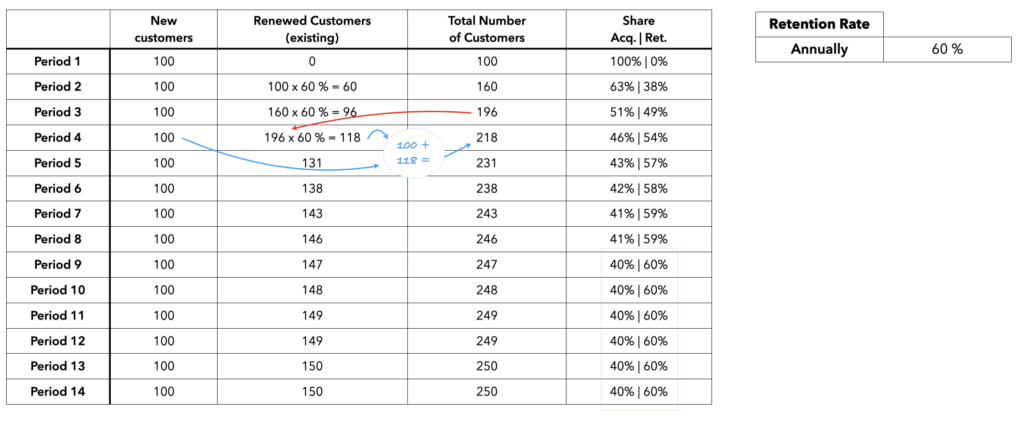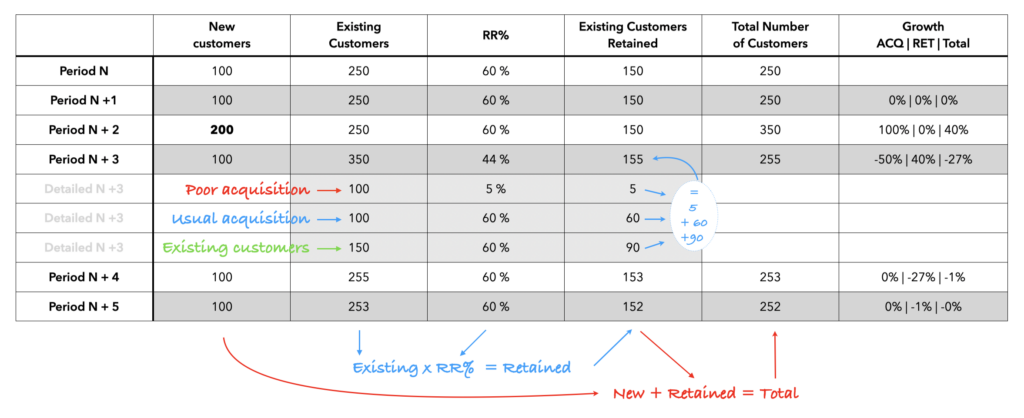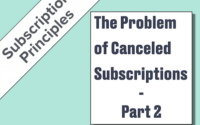Acquisition & Retention: Which comes first? Who leads whom?
Summary
In the growth phase, Acquisition leads.
In a mature business, Acquisition serves Retention. Retention dictates the target volume of new customers and specifies their ideal characteristics.
A subscription business focuses on two activities: acquiring new customers and retaining existing ones. Simply put, acquisition is like hunting, and retention is like farming.
It’s fair to ask which is more important:
- Should retention adapt to the acquired customers and aim to stay constant?
- Or does retention performance dictate acquisition needs?
Are these two activities linked or can they exist independently of each other?
Finally, from the launch of my subscription business to its maturity, how do acquisition and retention evolve?
1. In the growth phase (launch)
When you start a subscription business, you only acquire new customers.
The acquisition will target an audience as wide as possible. After renewal, the most loyal customers will become the core target.
In the growth phase, Acquisition drives the business.
2. End of the growth phase
When can we say that our subscription business is no longer in the launch phase? The answer is subjective. However, we can estimate it based on the proportion of acquisition in the total business.
As long as acquisition proportion exceeds churn, we are in the growth phase.
How can we say this?
In my article “Is infinite growth possible?“, we calculate the maximum number of subscribers based on the retention rate and the number of new subscribers.
Let’s take this same table and add a column giving the shares of acquisition and retention in the total business.

Table #1 : Total number of customer over time with share of Acq vs Ret
In this example, we acquire 100 new customers per year with a retention rate of 60%. After a few periods, we reach the limit of 40% Acquisition and 60% Retention which corresponds to the moment when the system is in equilibrium: Acquisition exactly balances Churn.
Everyone is free to define what growth is, but whatever happens, (in this example) from period 9, there is no more growth.
3. In the maturity phase
My subscription business is now mature, it has been launched for several periods. My growth is now low or zero; retention is the main part of my business.
As I know the characteristics of the customers I retain the best and I seek to acquire more of them. I can describe my typical customer in terms of acquisition channel, product purchased, price paid, payment method used.
In the maturity phase, retention drives the business.
4. Why is it important for retention to drive acquisition?
a. Do not decline
In a subscription business, acquisition must compensate for the number of customers who are not retained (aka Churn). Otherwise, the business declines.
The objective in term of acquisition volume is dictated by the retention rate.
b. Do not lower the retention rate
If Acquisition team acquires lots of customers without taking into account the ideal characteristics of the best retaining customer, we risk lowering the retention rate. In addition, we create unsustainable expectations for the following years in terms of growth.
Not convinced?
Let’s imagine that the Acquisition team has the opportunity to double the number of new customers through a channel that doesn’t usually have a good retention rate. Let’s take as an example, a site equivalent to Groupon. These customers are interested in brands but even more in discounts.

Table #2 : Impact of poor acquisition on Growth over time
In this example, Acquisition is doubled in period N + 2. We add 100 new customers who will have a retention rate (RR%) of 5% against 60% for the 100 acquired in the usual way.
- In period, N + 2, acquisition is doubled. Growth in Acquisition is 100% and 40% for the total.
- In period, N + 3, Acquisition returns to its usual level; growth in Acquisition is -50%. Meanwhile, in retention, the 100 additional customers have a RR% of 5% which causes the overall RR% to drop from 60% to 44%. Growth in Retention is 40% but overall growth is -27%.
- In period N + 4, the overall RR% returns to its level of 60%, i.e. +35% YoY. However, the number of subscribers decreases by -27% in retention and -1% overall.
As we can see, if we acquire a significant number of customers with non-homogeneous characteristics, the KPIs are impacted over 3 periods with variations that seem contradictory. As a consequence, it’s very difficult to explain [to investors] why the retention rate is increasing by 35% YoY while the number of subscribers in retention falls by -27% YoY.
Key takeaways
- The ideal acquired customer is the customer that we retain easily and for a long time. The Acquisition team must find customers that meet the Retention criteria.
- A retained customer is a customer that we do not have to acquire. The retention rate defines the number of customers to Acquire.
- It’s counterproductive to acquire at all costs. We create fluctuations in KPIs that impact our ability to forecast. We create variations in growth in YoY subscribers that are not reproducible.



